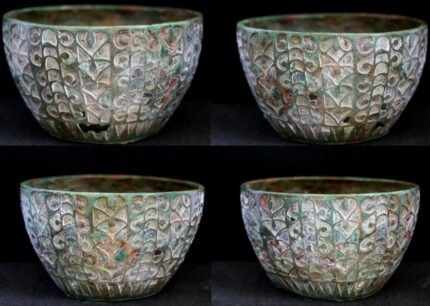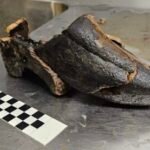 A Roman bronze enameled cup has been identified from a 6th century burial in the Anglo-Saxon burial ground at Scremby on the east coast of Lincolnshire. While vessels of this type have been found in the UK before, this is a rare example unearthed from its original context during a modern, secure archaeological excavation instead of by amateur metal detectorists and antiquarians of centuries past.
A Roman bronze enameled cup has been identified from a 6th century burial in the Anglo-Saxon burial ground at Scremby on the east coast of Lincolnshire. While vessels of this type have been found in the UK before, this is a rare example unearthed from its original context during a modern, secure archaeological excavation instead of by amateur metal detectorists and antiquarians of centuries past.
The burial ground was first discovered by a metal detectorist in 2018. He found a few Anglo-Saxon artifacts and reported them to the Lincolnshire Finds Liaison Officer. The nature of the objects suggested they may be grave goods, so University of Sheffield archaeologists were engaged to excavate the site. Over the course of their investigation, the team unearthed 49 graves dating to between 480 and 540 A.D., almost all of them containing a rich complement of funerary goods. Many of the deceased were women buried with exceptionally lavish arrays of jewelry, grooming tools and accessories.
Since the excavation, the contents of the graves, including the human remains, metal artifacts and elephant ivory bag rings, have been analyzed by researchers in multiple disciplines. The ivory rings were roughly contemporary with the burials, expensive imports from Kingdom of Aksum in what is now Eritrea, symbols and wealth and status to the women who wore them and were buried with them.
 In contrast to most of the other graves, the burial containing the Roman cup was modest. It belonged to an adolescent female who was interred wearing only two plain annular brooches and a pair of wrist clasps, jewelry that was so common they’ve been found in 90% of 6th century female burials in Lincolnshire. Only two of the 48 other burials have fewer grave goods than hers.
In contrast to most of the other graves, the burial containing the Roman cup was modest. It belonged to an adolescent female who was interred wearing only two plain annular brooches and a pair of wrist clasps, jewelry that was so common they’ve been found in 90% of 6th century female burials in Lincolnshire. Only two of the 48 other burials have fewer grave goods than hers.
The cup, however, was unique and special. Only two other containers were found in Scremby graves, and both of them were plain ceramic vessels buried in male graves that had other rich furnishings including shield bosses, spears and knives. It was placed near her head and unlike other fragments of Roman metalwork found in the burial ground, it was intact and in usable condition. It even retains its soldered base, made of a thin sheet of metal (.8mm at its thickest) so fragile that comparable vessels usually are missing this piece. It is 2.25 inches high and at full volume would have contained no more than 9.5 fluid ounces of liquid. The exterior is decorated with vertical panels of insets in different half-moon, heart, trumpet and triangle shapes that were infilled with enamel in bright colors of aquamarine, red and deep purple-blue. None of the enameled bronze Roman vessels on the archaeological record of Britain share the same design pattern. Closer, but not identical, parallels are known from France.
The French examples date to the second half of the 3rd century, and while similar British vessels were previously believed to date to the 1st or 2nd century, metallurgic analysis of the cup found the alloy was consistent with that produced in Roman Britain in the 3rd century. That means this cup was probably at least 300 years old when it was buried with the girl at Scremby.
A micro-excavation of the soil inside the cup found organic residue just above the base. Analysis of the residue sample found high concentration of saturated fatty acids consistent with degraded pig fat. Researchers could not determine whether the fat had been cooked — as part of a stew, for example — or whether it was raw. If the latter, it could conceivably had had a cosmetic purpose, but that is unlikely in the absence of any other ingredients commonly found in cosmetic preparations. It could instead have been medicinal, as 6th century sources do claim the Franks used raw bacon fat to cure intestinal problems and aid in the clean healing of wounds. The cup’s placement in a prominent place within a burial suggests it had ritual significance, and as the only vessel found inside a female grave and the only one with organic residue, it seems likely it fulfilled some unknown ceremonial function.
As for how a 3rd century cup wound up in a young girl’s grave three centuries later, there are two probable scenarios: it was scavenged from a Roman grave for reuse as a funerary object, or it was a lovingly preserved family heirloom. Scans of the cup found no evidence of repair, which such a fragile item almost certainly would have required had it been in active use for 300 years. On the other hand, it was fragile enough that the wafer-thin base, at least, would have been damaged even if it had been concealed in a grave for all that time. It would have had to have bene treated with kid gloves, not like a utilitarian object, for generations to make it into the girl’s grave intact.
Her skeletal remains and those of the other deceased in the Scremby burials are now undergoing DNA analysis, so additional information about her may yet come to light. The study of the cup has been published in the European Journal of Archaeology and can be accessed in its entirety here.







